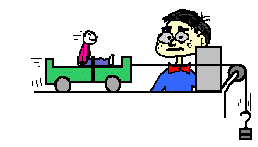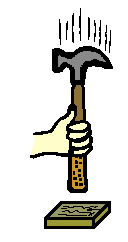Newton's First Law
the variety of ways
by which motion can be described (words, graphs, diagrams, numbers,
etc.) was discussed. In this unit (Newton's Laws of Motion), the ways in which
motion can be explained will be discussed. Isaac Newton (a 17th century
scientist) put forth a variety of laws that explain why objects move (or don't
move) as they do. These three laws have become known as Newton's three laws of
motion. The focus of Lesson 1 is Newton's first law of motion
sometimes
referred to as the law of
inertia
An object at rest stays at rest and an object in motion stays in motion with the same speed and in the same direction unless acted upon by an unbalanced force
There are two parts to this statement - one that predicts the
behavior of stationary objects and the other that predicts the behavior of
moving objects. The two parts are summarized in the following diagram
The behavior of all objects can be described by saying that objects tend to
"keep on doing what they're doing" (unless acted
upon by an unbalanced force). If at rest, they will continue in this same
state of rest. If in motion with an eastward velocity of 5 m/s, they will
continue in this same state of motion (5 m/s, East). If in motion with a
leftward velocity of 2 m/s, they will continue in this same state of motion (2
m/s, left). The state of motion of an object is maintained as long as the object
is not acted upon by an unbalanced force. All objects resist changes in
their state of motion - they tend to "keep on doing what they're doing
Suppose that you filled a baking dish to
the rim with water and walked around an oval track making an attempt to complete
a lap in the least amount of time. The water would have a tendency to spill from
the container during specific locations on the track. In general the water
spilled when:
- the container was at rest and you attempted to move it
- the container was in motion and you attempted to stop it
- the container was moving in one direction and you attempted to change its direction.

The
water spills whenever the state of motion of the
container is changed. The water resisted this change in its own state of motion.
The water tended to "keep on doing what it was doing." The container was moved
from rest to a high speed at the starting line; the water remained at rest and
spilled onto the table. The container was stopped near the finish line; the
water kept moving and spilled over container's leading edge. The container was
forced to move in a different direction to make it around a curve; the water
kept moving in the same direction and spilled over its edge. The behavior of the
water during the lap around the track can be explained by Newton's
first law of motion.
Everyday Applications of Newton's First Law
There are many applications of Newton's first law of motion.
Consider some of your experiences in an automobile. Have you ever observed the
behavior of coffee in a coffee cup filled to the rim while starting a car from
rest or while bringing a car to rest from a state of motion? Coffee "keeps on
doing what it is doing." When you accelerate a car from rest, the road provides
an unbalanced force on the spinning wheels to push the car forward; yet the
coffee (that was at rest) wants to stay at rest. While the car accelerates
forward, the coffee remains in the same position; subsequently, the car
accelerates out from under the coffee and the coffee spills in your lap. On the
other hand, when braking from a state of motion the coffee continues forward
with the same speed and in the same direction, ultimately hitting the
windshield or the dash. Coffee in motion stays in motion.

Have
you ever experienced inertia (resisting changes in your state of motion) in an
automobile while it is braking to a stop? The force of the road on the locked
wheels provides the unbalanced force to change the car's state of motion, yet
there is no unbalanced force to change your own state of motion. Thus, you
continue in motion, sliding along the seat in forward motion. A person in motion
stays in motion with the same speed and in the same direction ... unless acted upon by the unbalanced force of a seat belt.
Yes! Seat belts are used to provide safety for passengers whose motion is
governed by Newton's laws. The seat belt provides the unbalanced force that
brings you from a state of motion to a state of rest. Perhaps you could
speculate what would occur when no seat belt is used.

There are many more applications of Newton's first law of motion. Several applications are listed below. Perhaps you could think about the law of inertia and provide explanations for each application.
Blood rushes from your head to your feet while quickly stopping when riding on a descending
elevator.
The head of a hammer can be tightened onto the wooden handle by banging the bottom of the handle
against a hard surface.
A brick is painlessly broken over the hand of a physics teacher by slamming it with a hammer.


ليست هناك تعليقات:
إرسال تعليق